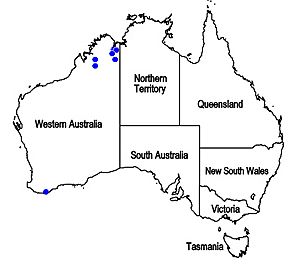Pityrodia obliqua facts for kids
Quick facts for kids Pityrodia obliqua |
|
|---|---|
| Conservation status | |
| Scientific classification | |
| Genus: |
Pityrodia
|
| Species: |
obliqua
|
 |
|
| Where this plant has been found in Australia | |
Pityrodia obliqua is a special kind of flowering plant that belongs to the mint family, called Lamiaceae. You can only find it growing naturally in the Kimberley region of Western Australia. This plant is an upright shrub with fuzzy stems. Its leaves are shaped like eggs and look a bit wrinkled. The flowers are pink and shaped like bells, with pretty purple stripes inside.
Contents
What it Looks Like
Pityrodia obliqua is an upright shrub, which means it grows straight up. It usually reaches a height of about 60 to 120 centimeters (about 2 to 4 feet). Its branches are covered in soft, greenish-grey hairs.
The leaves of this plant are shaped like an egg with a rounded tip. They are usually between 30 and 60 millimeters (about 1 to 2.5 inches) long and 10 to 25 millimeters (about 0.4 to 1 inch) wide. Each leaf has a small stem, called a petiole, which is about 10 to 18 millimeters long. Both sides of the leaves are hairy, and the top surface looks a bit wrinkled. You can also see the veins clearly on the underside of the leaves.
Flowers and Fruit
The flowers of Pityrodia obliqua grow in groups of three to seven. These groups are found where the leaves meet the stem, which is called the leaf axil. The flower stalks and the outside parts of the sepals (which protect the flower bud) and petals are covered in soft, woolly hairs.
The five sepals are only joined together near their bottom. The petals are pink with purple stripes inside. They are usually 8 to 12 millimeters long. Inside, the petals are mostly smooth, except for a ring of hairs just above the ovary (where the seeds develop) and some long hairs on the lowest petal. The petals are joined to form a tube, which is about as long as the sepals. This tube has five uneven lobes, or sections. The bottom middle lobe is round and about 3 to 4 millimeters long and 4 to 6 millimeters wide. The other four lobes are egg-shaped and smaller.
This plant has four stamens (the parts that produce pollen) that stick out a little from the end of the flower tube. Two of these stamens are slightly shorter than the other two. Pityrodia obliqua flowers from May to July. After the flowers, a small, black, almost round fruit grows. It is about 2 to 3 millimeters across.
How it Got its Name
The plant Pityrodia obliqua was officially described for the first time in 1918 by a person named William Vincent Fitzgerald. He published his description in a scientific paper called Journal and Proceedings of the Royal Society of Western Australia.
The second part of the plant's name, obliqua, comes from a Latin word. It means "slanting," "sideways," or "indirect."
Where it Lives
You can find Pityrodia obliqua only in the Kimberley region of Western Australia. It likes to grow in rocky areas within mountain ranges.
Protecting This Plant
The Government of Western Australia's Department of Parks and Wildlife has classified Pityrodia obliqua as "Priority One". This means that the plant is known to grow in only a few places, and these places might be at risk. Because of this, it's important to protect these areas to help this special plant survive.


